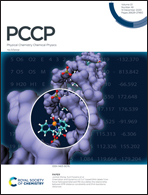Structural characterization, reactivity, and vibrational properties of silver clusters: a new global minimum for Ag16†
Abstract
In the present work, the lowest energy structures and electronic properties of Agn clusters up to n = 16 are investigated using a successive growth algorithm coupled with density functional theory calculations (DFT). In the literature, a number of putative global minimum structures for silver clusters have been reported by using different approaches, but a comparative study for n = 15–16 has not been undertaken so far. Here, we perform a comparative study using the PW91/cc-pVDZ-PP level to more precisely determine the optimal configuration. For Ag15, the most stable configuration is a four layered 1-4-6-4 stacking structure with C2v symmetry. For Ag16 a new most stable form is found with a 1-4-2-5-1-3 stacking structure in the singlet state, slightly more stable than the putative global minimum reported. By means of the electrostatic potential, the new putative global minimum has been found to be more reactive, and the active sites of the clusters were identified and confirmed with the interaction energy. The electronic and vibrational properties are found to be in good agreement with the available experimental data. Theoretical data on the infrared spectra of the clusters is also provided.



 Please wait while we load your content...
Please wait while we load your content...